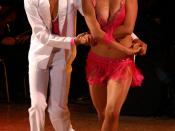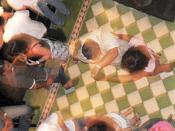Latin America Cultural Project and Festival
They are not sure who invented the Salsa but it is a mix of many Latin and Afro-Caribbean dances. Similar to the Mambo, Salsa has a pattern of six steps danced over eight counts of music. The dance has a side to side feel and the turns and twists are an important feature. Also the dancers move all around the floor where the Mambo is much more linear were it is all in one line.
The Salsa originated basically in Cuba, all though there was a mix of many more cultures in the dance. The Contra-Danze (Country Dance) brought by the French who where fleeing from Haiti, the Rhumbas of African origin from Guaguanco, Colombia, and Yambú, and finally the Són of the Cuban people which was a mix of the Spanish troubadour and the African drumbeats, which all mixed together and the Salsa was born.
A long list of several Hispanic dances include the Rhumba, Són Montuno, Guaracha, Mambo, Cha cha, Danzón, Són, Guguanco, Cubop, Guajira, Charanga, Cumbia, Plena, Bomba, Festejo, and finally the Merengue made the Salsa.
The Salsa started in Cuba and migrated to New York when Puerto Ricans started to migrate to New York in the 1940s and 1950s. This is when Latino dance started to become very popular. It is said that movies of the Salsa might have had a big impact on the growing popularity of the Salsa. Puerto Rican bands such as the Tito Puente, Tito Rodriguez, and Cuba's Machito created the style of music for the Salsa. The traditional instruments used in the Salsa are the bongos, double bass, cow-bells, and most importantly, the claves.
Salsa means "sauce", so the dancers should bring out a hot and spicy interaction with each other. Eye...


